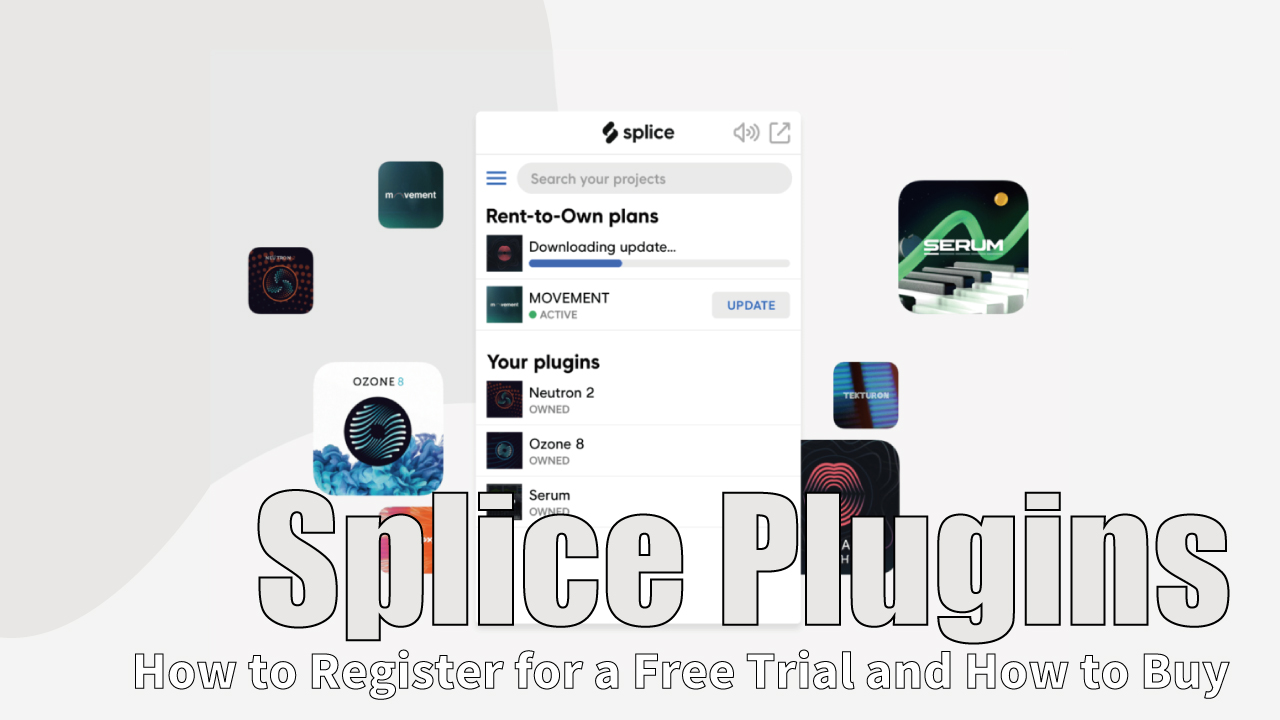I will review Arturia’s “V Collection 9,” a virtual software instrument that covers major iconic synthesizers and keyboard instruments. It can be a bit challenging to master, but it is a recommended software instrument even for beginners in composition, as it offers a learning opportunity.
With the upgrade to V Collection 9, a new series called Augmented has been added, which combines acoustic sounds and synthesizers instead of emulating specific iconic synthesizers and keyboard instruments. This package now offers a broader range of sounds.
In this review, I would like to go through each included instrument in V Collection 9, discussing the benefits and points to note about its installation. Please feel free to use it as a reference.
1. What is Arturia “V Collection 9” ?
V Collection 9 is a software instrument bundle developed by Arturia, a company known for producing hardware synthesizers. It covers a wide range of iconic synthesizers and keyboard instruments. In addition to vintage synthesizers, it also includes piano, electric piano, organ, and more, recreated using their unique emulation technology and physical modeling.
Each software instrument is also available for individual purchase. The newly added Augmented series combines acoustic sounds and synthesizers, rather than emulating specific iconic synthesizers and keyboard instruments, providing an even broader range of sounds.
It can be used as a plugin extension (VST, AU, AAX) for music production software (DAW) and is also compatible with NKS, allowing integration with Native Instruments controllers and others. Additionally, it can be used as a standalone application.
| Development company | Arturia |
| Price(list price) | $599 Splice Plugins $24.99 / 24 months |
| Software (24 types) | Mellotron / EMS Synthi AKS / Casio CZ Series Hammond-B3 / Hohner Clavinet / Fairlight CMI /YAMAHA DX7 BUCHLA Music Easel / Synclavier / Minimoog / 12 Pianos Rhodes / Oberheim Matrix 12 / Farfisa Compact Deluxe Combo Organ Vox Continental 300 / Solina / Oberheim Sem / Wurlitzer Roland Jupiter-8 / ARP 2600 / Yamaha CS-80 / Prophet 5 / Prophet VS Moog IIIc / E-Mu Emulator II / Oberheim OB-Xa / Roland Juno-6 Moog 16 Channel Vocoder / Korg MS-20 / Ensoniq SQ-80 |
| Release date | May 2019 |
System Requirements
Mac OS 10.13 or higher
- 4 GB RAM
- 4-core CPU, 3.4 GHz (4.0 GHz Turbo-boost) or M1 CPU
- 32 GB free hard disk space
- GPU with OpenGL 2.0 support
Win 10+ (64-bit)
- 4 GB RAM
- 4-core CPU, 3.4 GHz (4.0 GHz Turbo-boost)
- 32 GB free hard disk space
- GPU with OpenGL 2.0 support
V Collection is also available for monthly payments through Splice Plugins, offering a Rent-to-Own option. You can find more detailed information about Splice Plugins in this article. Unlike regular monthly payments, Splice Plugins allows you to stop payments at any time without any obligation, and once fully paid, the software becomes yours to keep.
Arturia V Collection 9
Plugin Boutique
2. Upgrades and Additions in Version 9
With the update to Version 9, the following four new instruments have been added:
- Korg MS-20 V: A synth with a classic analog sound and semi-modular architecture, modeled after the Korg MS-20.
- SQ 80 V: A hybrid lo-fi cross-wave synth that combines thousands of digital waveforms with crunchy analog filters, modeled after the Ensoniq SQ-80.
- Augmented STRINGS: A hybrid instrument that combines sampled strings with cutting-edge synthesis and deep morphing control.
- Augmented VOICES: A hybrid instrument that blends human voices with multiple synth engines and expressive control.
Previous updates mainly focused on adding instrument models emulating specific iconic synthesizers, but the new Augmented series combines acoustic sounds and synthesizers. Additionally, the following existing instruments have been reimagined:
- CS-80 V 4: A completely rebuilt version of the Yamaha CS-80 model synth.
- Prophet-5 V / Prophet-VS V: Originally combined as Prophet V, they are now separate instruments representing the Prophet 5 and Prophet VS models.
- Piano V 3: A physical modeling piano instrument that recreates 12 different models, ranging from vintage grand to modern cinematic sounds
3. Benefits of Introducing V Collection 9
There are several advantages to introducing Arturia’s “V Collection 9”:
- Access to a comprehensive collection of famous keyboard instruments and synthesizers
- Quick and easy discovery of desired sounds from a wide range of presets
- Ability to produce delicate sounds through unique analog emulation systems and physical modeling
(1)Access to a comprehensive collection of famous keyboard instruments and synthesizers
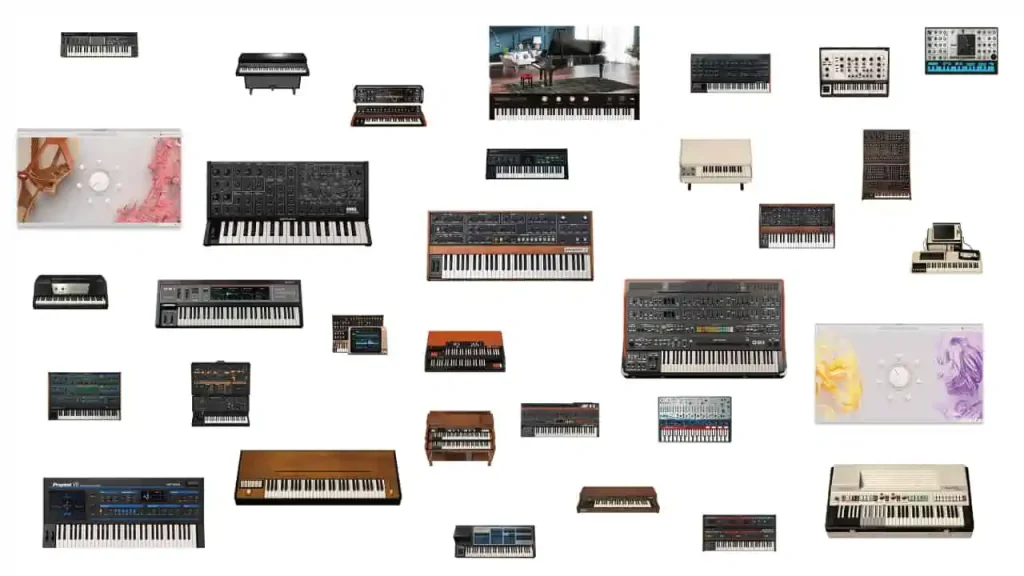
V Collection is a cost-effective bundle that allows you to acquire a wide range of well-known keyboard instruments and synthesizers, including pianos, electric pianos, and organs. For those who don’t have any software instruments yet, it is highly recommended as it provides comprehensive coverage of keyboard instruments and synths in a single purchase. Here are the original instruments that each software instruments is based on:
- Mellotron V → Mellotron
- Synthi V → EMS Synthi AKS
- CZ V → Casio CZ series
- B3 V2 → Hammond B3
- Clavinet V → Hohner Clavinet
- CMI V → Fairlight CMI
- DX7 V → Yamaha DX7
- Buchla Easel V → BUCHLA Music Easel
- Synclavier V → Synclavier
- Mini V → Minimoog
- Piano V → 12 different pianos
- Stage-73 V → Rhodes
- Matrix-12 V → Oberheim Matrix 12
- Farfisa V → Farfisa Compact Deluxe Combo Organ
- Vox Continental V → Vox Continental 300
- Solina V → Solina
- SEM V → Oberheim SEM
- Wurli V → Wurlitzer
- Jup-8 V → Roland Jupiter-8
- ARP 2600 V → ARP 2600
- CS 80 V → Yamaha CS 80
- Modular V → Moog IIIc
- Jun-6 V → Roland Juno-6
- Vocoder V → Moog 16 Channel Vocoder
- OB-Xa V → Oberheim OB-Xa
- Emulator II V → E-Mu Emulator II
- Korg MS-20 V → Korg MS-20
- SQ 80 V → Ensoniq SQ-80
- Prophet-5 V → Prophet 5
- Prophet-VS V → Prophet VS
- Augmented STRINGS: Strings x Synth
- Augmented VOICES: Human voices x Synth
(2)Quick and easy discovery of desired sounds from a wide range of presets

The presets are abundant and can be displayed separately by parts, making it easy to find the desired sound. There are over 10,000 presets in total. Particularly, Analog Lab V, which allows control over all individual software instruments and the separately sold software synth Pigments, is convenient. By setting instrument types, genres, sound designers, and various conditions, you can easily find sounds that require mixing and achieve a fast production workflow. Intuitive macro controls allow you to grasp the essential elements of each preset, and you can access the full interface of V Collection with a single click to control the full range of tones. In other words, each layered synth can be adjusted for each parameter individually, just like when launched separately (also applicable if you have Pigments).
(3)Ability to produce delicate sounds through unique analog emulation systems and physical modeling
What sets Arturia’s software synthesizers apart from others is the use of Arturia’s proprietary technology to digitally replicate analog circuits. By dynamically generating sounds, they are capable of producing unique, vibrant, and thick tones. Additionally, acoustic instruments are recreated using physical modeling techniques. These factors contribute to the flexibility and functionality of Arturia’s synthesizers, offering capabilities beyond what can be achieved with sample-based instruments.
Arturia V Collection 9
Plugin Boutique
4. Points to be aware of and disadvantages to consider before using
However, there are important points to be aware of and potential disadvantages to consider before using:
- Pay attention to the types of included software instruments! Other products may be better suited for certain needs.
- CPU load is high
(1)Pay attention to the types of included software instruments! Other products may be better suited for certain needs.
One of the attractions of V Collection 9 is that it covers not only vintage synthesizers but also keyboard instruments. However, depending on individual preferences, it may be more appropriate for some people to purchase other software instruments. For example, if you are primarily interested in vintage synthesizers, UVI’s “Vintage Vault 4” offers a wider variety, including rhythm machines.
Another significant difference is whether the software instruments are sample-based or not. While products like UVI’s are recorded from actual instruments, V Collection uses proprietary technology to digitally emulate analog circuits. This often results in a thicker and more lively sound for analog-based instruments, which is a matter of personal preference. Additionally, in terms of functionality, V Collection often offers more capabilities compared to sample-based products like UVI, including individual parameter control for each software instruments.
Here are some examples of software instrument collections and vintage synthesizer software instruments:
- Arturia “V Collection 9”: Keyboard instruments (pianos, electric pianos, organs, etc.), vintage synthesizers
- UVI “Vintage Vault 4”: Vintage synthesizers, rhythm machines
- UVI “Synth Anthology 3”: Vintage synthesizers to modern synths, controlled by a common set of parameters within a single plugin.
- IK Multimedia “Syntronik 2”: Vintage synthesizers, controlled by a common set of parameters within a single plugin.
- Native Instruments “Komplete 14”: Comprehensive collection covering almost all types of software instruments. However, most of their synthesizers are proprietary, with fewer models based on vintage synthesizers.
- IK Multimedia “SampleTank 4”: Comprehensive collection covering almost all types of software instruments, controlled by a common set of parameters within a single plugin.
If you are specifically interested in keyboard instruments other than synthesizers, I would also recommend Spectrasonics “Keyscape.” However, please note that Keyscape does not include organ software instruments.
(2)CPU load is high
Some have a high CPU load.
Very high : Synthi V, Buchla Easel V
High : Mellotron V, CZ V, Clavinet V, DX7 V, Matrix-12 V, Vox Continental V
5. Sale Information for V Collection 9
Arturia products go on sale not only during Black Friday but also at other times. The discount rates are often quite high, with many items being discounted by around 50%. This includes not only V Collection 9 but also various individual software instruments. It is also possible to purchase V Collection 9 through crossgrades and upgrades. If you log in to the Arturia official website and go to “MY ACCOUNT,” you may find information about crossgrade and upgrade prices listed there.
Arturia V Collection 9
Plugin Boutique
6. Installation and Activation Process for Arturia Products
The installation and authorization process for Arturia products can be completed in the following 4 steps:
- Create an account and log in to Arturia.
- Click on the person icon in the top right corner, go to “MY ACCOUNT,” and select “Register New Product.” Enter the Serial Number (SN) and Unlock Code (UC) to register the product.
- Download and install the Arturia Software Center (ASC).
- Launch ASC, log in, and activate/install the product.
7. Review each software instruments of V Collection 9
I will review each software of V Collection 9 one by one.
- Mellotron V
- Synthi V
- CZ V
- B3 V2
- Clavinet V
- CMI V
- DX7 V
- Buchla Easel V
- Analog Labs V
- Synclavier V
- Mini V
- Piano V
- Stage-73 V
- Matrix-12 V
- Farfisa V
- Vox Continental V
- Solina V
- SEM V
- Wurli V
- Jup-8 V
- ARP 2600 V
- CS 80 V
- Modular V
- Emulator II V
- OB-Xa V
- Jun-6V
- Vocoder V
- Prophet-5 V
- Prophet-VS V
- Augmented STRINGS
- Augmented VOICES
- KORG MS-20 V
- SQ 80 V
(1)Mellotron V
Mellotron V is an instrument modeled after the Mellotron and offers approximately 61 presets. It expands the possibilities for keyboard players to create orchestral and choir sounds with just one keyboard. It includes all the original tapes and features its own sample playback function using tape emulation.
The Mellotron sound, famously heard in The Beatles’ “Strawberry Fields Forever,” is well-known. While there are several Mellotron plugins available, what sets Mellotron V apart is its ability to incorporate custom samples, including your own recordings. Additionally, you can combine and utilize three layers. It comes with a substantial number of default samples, surpassing the functionality of UVI’s Mello in their Vintage Vault collection.
(2)Synthi V
Synthi V is a synthesizer modeled after the EMS Synthi AKS, featuring approximately 295 presets. It is a British-born silver machine that breathes new life into modular synthesis as a patch pin modular. It has been rejuvenated with expanded modulation options, powerful effects, an updated sequencer, and the ability to group pins for complete control.
While it is capable of producing rugged sounds, its unique pin matrix can be somewhat challenging to navigate. The vertical columns represent sources, while the horizontal rows represent destinations, each divided into two sections. Sources include oscillators and other signal-generating components, while Treatments require some form of input to produce an output, such as filters. Signal Inputs are used for connecting signals, while Control Inputs are for connecting control signals. One drawback is its high CPU load.
(3)CZ V
CZ V is a software synthesizer that models the Casio CZ series and offers approximately 455 presets. It is a legendary and affordable synthesizer that revolutionized digital synthesis with its phase distortion sound, which gradually alters the waveform over time. In its software form, it has been enhanced with added modulation and effects.
By looking at the waveform on the screen, you can see that the waveform itself changes over time. This can be adjusted using the DCW (Digital Control Waveform) found in the Advanced view. The DCW not only allows you to select preset waveforms but also enables you to create your own base and target waveforms by drawing them. In terms of usability, it is much more user-friendly compared to Cameo included in UVI’s “Vintage Vault.” It produces a uniquely distorted sound in a positive way.
(4)B3 V2
B3 V2 is a software organ that models the renowned Hammond B3 organ and offers approximately 50 presets. The rich sound of the electronic organ king, the B-3, has been cherished for over half a century as a staple in jazz, gospel, hard rock, and reggae. It features built-in rotary speaker and drawbar modulation, allowing for new effects such as animation and syncopation.
Some presets may have a booming sound that resembles noise, which is caused by the effects in the upper-right FX section. The perception of the sound wavering from left to right is due to the rotary speaker effect. If you don’t need or find it distracting, you can simply turn off the effects. Like other synthesizers, B3 V2 also allows modulation of envelopes and LFOs, and it includes a sequencer, enabling the creation of dynamic sounds. However, it may lack the realism in attack sounds compared to IK Multimedia’s “Hammond B3-X,” which is an officially licensed Hammond software instruments.
(5)Clavinet V
Clavinet V is a software clavinet that models the iconic Hohner Clavinet and offers approximately 75 presets. This fantastic instrument has been a cornerstone of funk, R&B, soul, and jazz sounds since its release, and Arturia’s modeling expertise has captured its original growl and dynamism. It allows you to apply amp simulations and up to five different effects. If you find the noise distracting, you can adjust the PICK UP NOISE parameter in the Advanced view. In addition to various parameters, you can also change the tonality using six different harmonic profiles.
Compared to the Clavinet in MODARTT’s physical modeling software instrument, Pianoteq, Pianoteq offers more user-friendliness and functionality that is typical of physical modeling, allowing for detailed sound shaping. Pianoteq is often seen as a piano software instrument, but it is also a versatile source for other keyboard instruments.
(6)CMI V
CMI V is a software synthesizer that models the iconic Fairlight CMI and offers approximately 426 presets. The original Fairlight CMI was the mother of samplers and a groundbreaking additive synthesizer that redefined pop music. The updated version includes 10 multi-timbral, polyphonic slots, real-time waveform shaping, effects, a sequencer, and a new spectrum synth.
Similar to Emulator II V, you can finely adjust each sample from the top screen. It is also possible to import your own samples. Furthermore, like CZ V, you can shape the waveforms yourself, and with 10 slots available, there are a wide range of possibilities. It features a sequencer as well, and there are presets that include drum sounds placed in each slot, allowing you to create retro rhythm machine grooves.
(7)DX7 V
DX7 V is a software synthesizer that models the iconic Yamaha DX7 and offers approximately 490 presets. It simplifies the programming method and expands the features with a mod matrix, custom envelopes, waveforms, a second LFO, and effects. Based on the legendary FM synthesizer, it produces distinctive metallic tones, and you can use the original 32 algorithms with six operators.
Note: The original Yamaha DX7 was a revolutionary digital synthesizer known for its FM (Frequency Modulation) synthesis, and the DX7 V is a software emulation that recreates its sound and functionality.
(8)Buchla Easel V
Buchla Easel V is a software synthesizer that models the renowned BUCHLA Music Easel, offering approximately 300 presets. The Music Easel, an analog synthesizer introduced by Don Buchla in 1973, is perfect for creating ambient, wide-screen textures and sequences, and exploring alternative sound design.
Buchla Easel V has a high CPU load. It features a sequencer and patch cables, which are distinctive characteristics of this synthesizer. The black patch cables indicate inputs, while other colors represent outputs. Although it may initially appear complex, the knobs and connection points are color-coded, grouping similar functions in the same area. Additionally, red circles indicate available connection points, making it easier to understand where to patch.
The Advanced view is also notable, featuring unique elements such as right-hand modulation parameters, left-hand keyboard/sequencer controls, and an unconventional XY control called “Gravity.” The Gravity feature allows you to place walls and planet objects that reflect freely moving points, similar to a pinball game. This provides precise control over the sound and enables the creation of unconventional and unrestricted sonic experiences.
(9)Analog Labs V
https://www.youtube.com/watch?v=RKRSBNOHro4&feature=emb_title
“Analog Lab V” is not only included with the software instruments in V Collection but also includes presets from the separate software synthesizer Pigments. By setting instrument types, genres, sound designers, and various criteria, you can easily find sounds that require mixing, achieving a faster production workflow. You can intuitively understand the essential elements of each preset using macro controls, and by calling up the full interface of V Collection, you can control the full tone with a single click. With an abundance of presets created by sound designers and others, you can layer each synthesizer and adjust parameters individually, just like when launching them separately (if you also have Pigments, you can control it as well). In Stage mode, you can use an easy-to-operate stage on a single screen.
Note, however, that combining individual synthesizers may increase the CPU load.
(10)Synclavier V
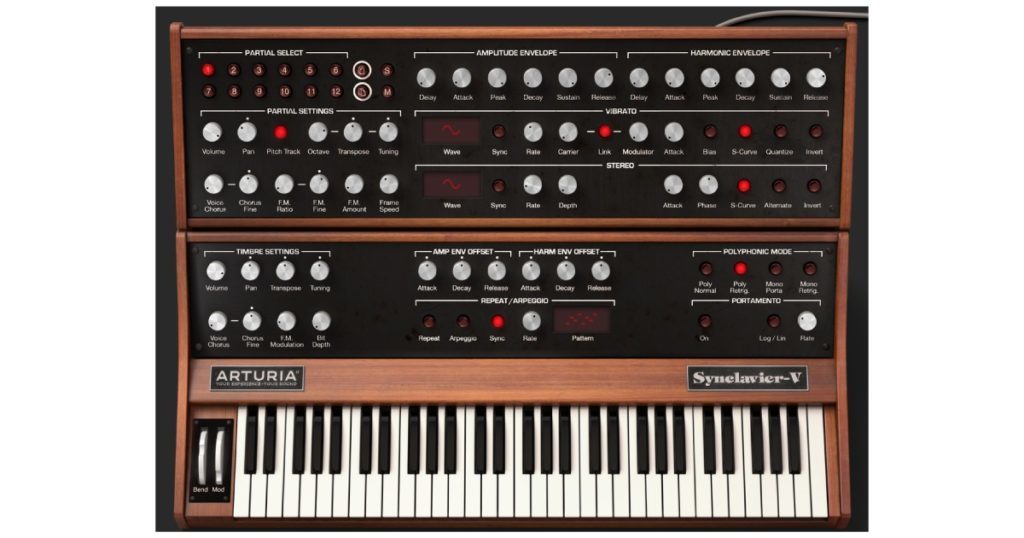
Synclavier V is a software synthesizer that models the iconic Synclavier, offering approximately 724 presets. Known for the familiar gong sound that opens Michael Jackson’s “Beat It,” this FM synth delivers a cool and distinctive sound. Developed in collaboration with the original designer, Cameron Jones, the synth has been faithfully recreated in software form. This elite digital synthesizer, which supported numerous hit songs and film soundtracks in the early 1980s, has been updated with expanded features and re-synthesis capabilities.
The synth features 12 partial timbres, each referred to as a layer, allowing you to independently customize carrier and modulator waveforms by adjusting harmonics and phases. By creating separate waveforms on the time axis, you can achieve dynamic changes and unique variations.
(11)Mini V
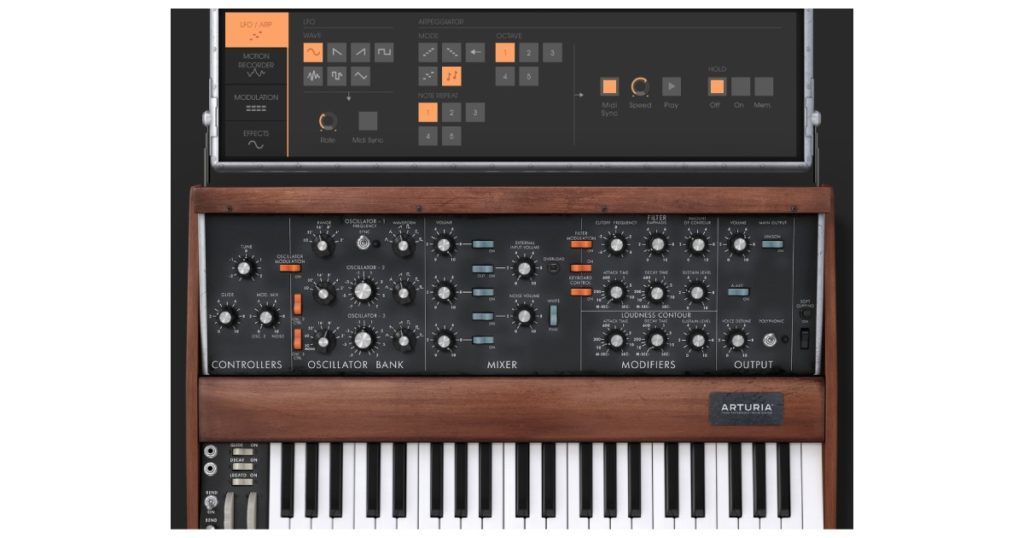
Mini V is a software synthesizer that models the iconic Minimoog, offering approximately 553 presets. This monophonic synthesizer is likely the most famous synth in history, renowned for its fat and warm bass and lead sounds that have become legendary. Developed in collaboration with Bob Moog himself, it includes new features that were impossible in the 1970s when the original was released. While the model is based on the monophonic analog synth, it is also capable of being polyphonic, offering a wide range of sounds that make you wonder, “Is this really the Minimoog?”
Furthermore, the Motion Recorder in the Advanced View allows for convenient modulation using freely drawn lines, adding another layer of versatility to the synth.
(12)Piano V
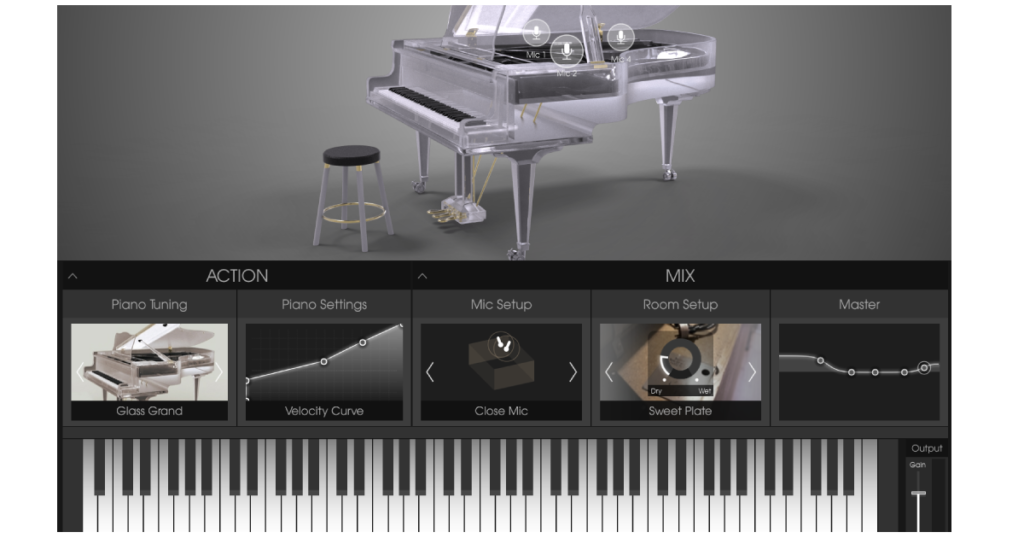
Piano V, consisting of 12 different pianos, has undergone a new evolution. Being a physical modeling piano instrument, it allows you to adjust the mic position, string characteristics, and hammer feel, enabling you to customize the instrument’s texture to your liking. You can also calibrate the velocity curve to match your MIDI keyboard.
With a wide range of presets, Piano V offers many unique and unconventional sounds, allowing you to achieve adjustments and tones that would be impossible in reality. It provides convenience and flexibility in its usage. While the sound quality may be inferior in some cases, it allows for sound design that goes beyond what is typically achievable with traditional piano instruments.
(13)Stage-73 V
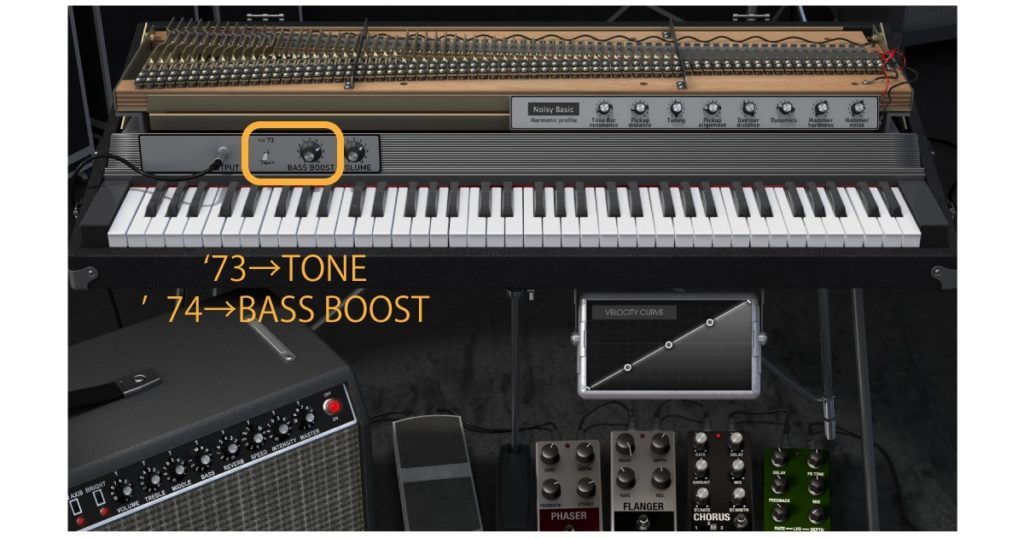
Stage-73 V, modeled after the Rhodes, offers approximately 80 presets. Using the power of physical modeling, it faithfully reproduces the iconic sound of the legendary Fender Rhodes, capturing every nuance from tines and cabinets to effects and amplifiers. In addition to being able to choose between Stage and Suitcase options from the top right, you can also select from seven different models in the Advanced view. The ’73 and ’74 in the Stage category represent different eras, where the left knob controls Tone for pre-’73 models and becomes BASS BOOST for models from ’74 onwards.
This instrument allows you to customize the sound by adjusting the structure itself, which is a unique feature of physical modeling. However, there are other similar options available, such as AAS “Lounge Lizard” and Pianoteq’s electric piano instruments. Compared to those, I feel that they may not be as widely utilized. By the way, personally, I enjoy the Pianoteq electric piano as it can produce a bright sound.
(14)Matrix-12 V
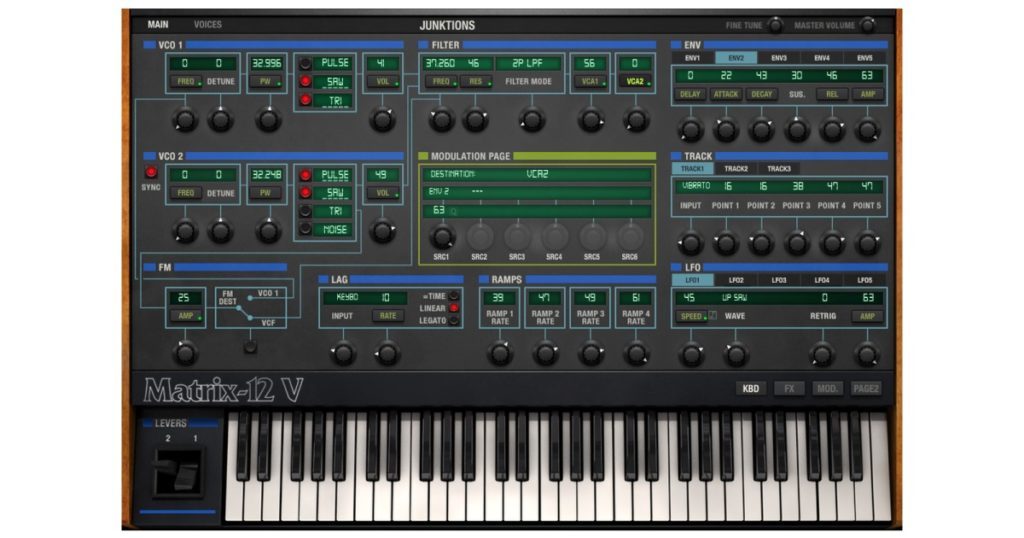
Matrix-12 V, modeled after the Oberheim Matrix 12, offers approximately 463 presets. The legendary analog polyphonic synthesizer, Matrix-12, achieved a distinctive Oberheim sound with its unparalleled matrix modulation and 15-mode filter. It has been further expanded by adding more modulation sources and a 27×47 matrix.
You can adjust each of the 12 voices and create rich, thick sounds. As there are few competing products, it is my favorite among the Oberheim models in the V Collection. However, since there are limited visual elements like waveform graphics, the interface might be a bit challenging to navigate.
(15)Farfisa V
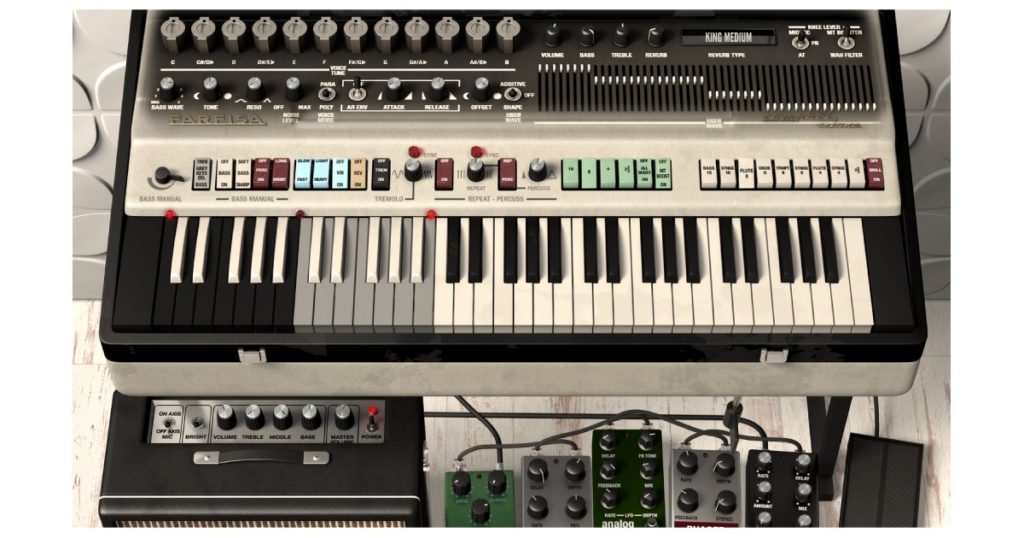
Farfisa V, modeled after the Farfisa Compact Deluxe Combo Organ, offers approximately 144 presets. The transistor organ has been the backbone of 1960s hit songs and continues to resonate in upbeat genres ever since. This classic sound is enhanced with synthesizer features like user-definable waveforms, envelopes, and effects.
It is characterized by a pleasantly cheap-sounding quality. The instrument includes a feature that allows adjusting the pitch of the keys from C to B, enabling intentional detuning for a further retro feel. The lower black and gray keys can also function as a bass part. Additionally, in the Advanced view, there are densely packed sliders for creating custom waveforms.
(16)Vox Continental V
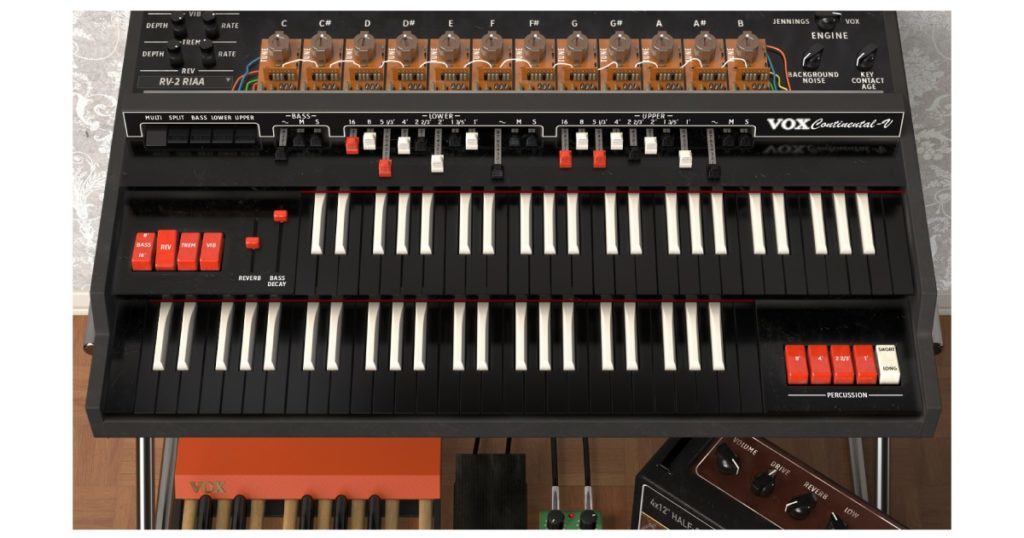
Vox Continental V, modeled after the Vox Continental 300, offers approximately 117 presets. The transistor drawbar organ quickly gained popularity during the “British Invasion” and became a hit factory on the West Coast. It includes the later Jennings J70 engine as well, with full drawbars, additional waveforms, rotary cabinet, and effects. The guitar amplifier is also modeled after Vox.
This organ is characterized by its distinctive black keys and can be controlled with a two-tier keyboard plus a pedalboard. In the Advanced view, there is a feature that allows adjusting the pitch of the keys from C to B, and it is also possible to switch between the Vox and Jennings engines, which produce slightly different sounds.
(17)Solina V

Solina V, modeled after the Solina, offers approximately 148 presets. Solina, an early hybrid of a proto-synth and an organ, produces electronically rich string and orchestral sounds. It provides both mono and stereo versions, as well as effects and new sounds inspired by the Polymoog.
It features a characterful string sound that may not be realistic but has its own unique flavor. Personally, I believe that String Machines 2, available in UVI Vintage Vault 3, which covers and combines various string synths, might be a better option.
(18)SEM V
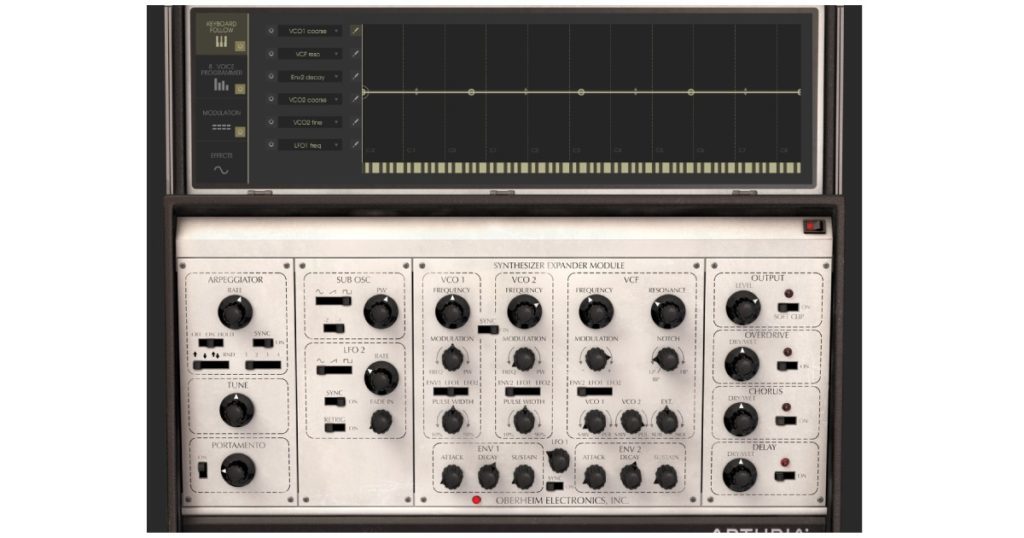
SEM V, modeled after the Oberheim SEM, offers approximately 574 presets. The original hardware required multiple units to achieve polyphony, with each unit producing one voice. However, with SEM V, it is naturally possible to have polyphonic capability. It has been updated with unique polyphony, modulation matrix, noise, sub-oscillator, arpeggiator, and portamento features.
However, in the Sem model (the 8-Voice model with 8 units), there is GForce Software’s “OB-E,” the first software synthesizer personally endorsed and praised by Tom Oberheim himself. With OB-E, you can individually adjust all parameters for each SEM unit, allowing you to explore the subtle differences in sound and achieve a thicker overall sound.
(19)Wurli V

Wurli V offers approximately 190 presets, modeled after the Wurlitzer. It is Arturia’s first classic keyboard emulation using physical modeling. It faithfully reproduces the acoustic characteristics of the instrument, including the sound of the reeds, hammers, mechanical noises, amplification, and resonances of the plastic body. This virtual instrument provides exceptional realism and flexibility.
When it comes to electric pianos, Rhodes and Wurlitzer are the iconic choices, and both are included in the V Collection. Compared to other software instruments, Wurli V may appear simpler with fewer parameters, but it is capable of producing a distinctive and flavorful sound. Since it is based on physical modeling, it is also possible to manipulate the sound structure and create sounds that deviate from the traditional Wurlitzer sound.
(20)Jup-8 V
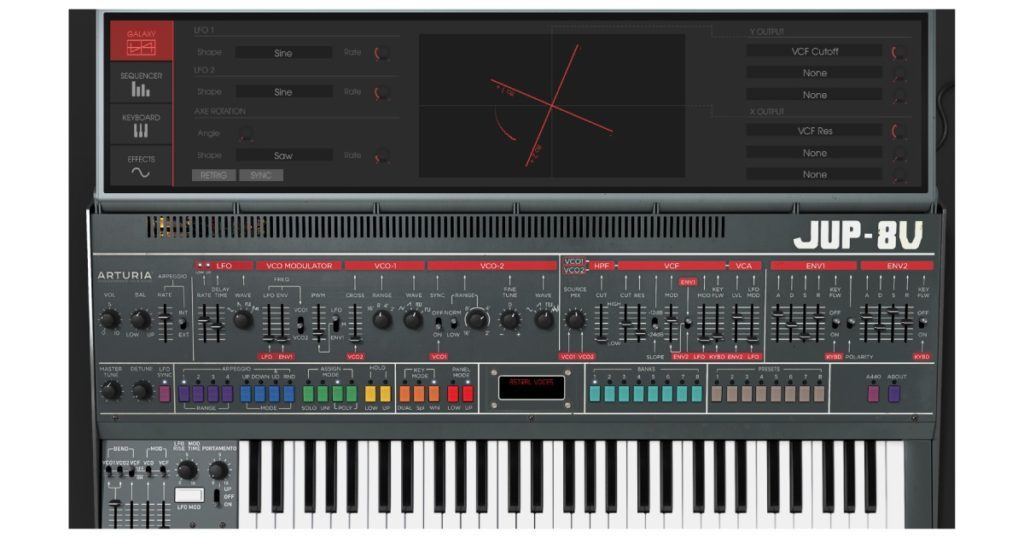
Jup-8 V offers approximately 581 presets modeled after the Roland Jupiter-8, an iconic synthesizer known for its vibrant appearance. This classic polyphonic synthesizer has a fat yet airy and clear sound, and it has been loved by various artists such as Prince, Duran Duran, Moby, and Depeche Mode.
While Roland Cloud, the official Roland platform, also features the Jupiter-8, Jup-8 V from Arturia incorporates their own unique features. It includes complex combinations of LFO modulation, dynamic effects with modulation capabilities, and an advanced step sequencer, setting it apart from the Roland Cloud version.
(21)ARP 2600 V
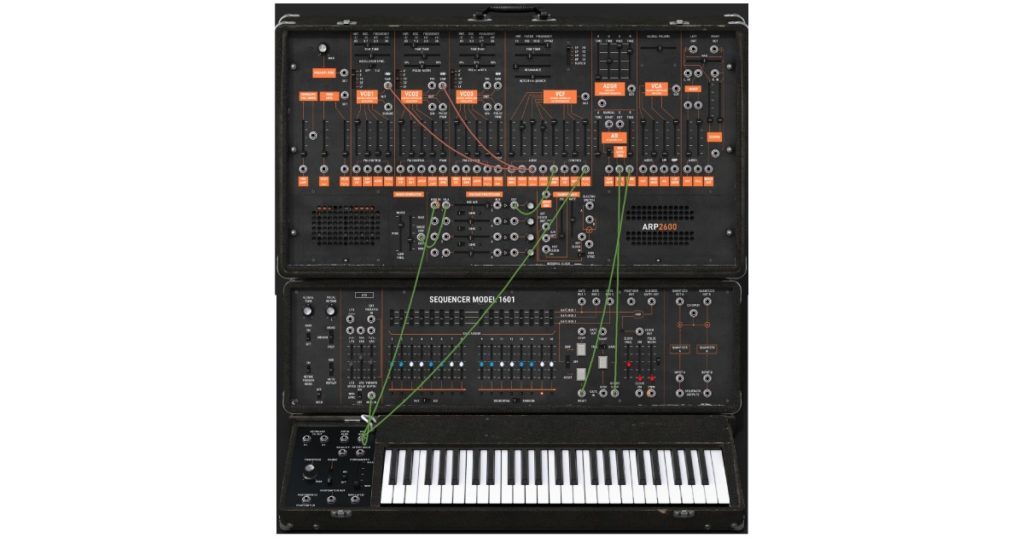
ARP 2600 V is a synthesizer modeled after the ARP 2600, offering approximately 604 presets. It features a design that resembles the original device, which can be carried in an attaché case, and it is characterized by having three oscillators. It includes patchable connections that can be overridden using patch cords, allowing for learning and exploration of synthesis, ranging from clear and bright leads to the voice of R2D2. It has been enhanced with features such as polyphony, a tracking generator module, a sequencer, and effects. By connecting various modules and controlling the signals with patch cables, it allows for a wide range of modulation possibilities. However, handling the patches may be challenging for beginners in the realm of synthesizers.
(22)CS 80 V

The CS 80 V, modeled after the Yamaha CS 80, has been updated. It is a polyphonic synthesizer with 8 voices and features two sets of VCOs, VCFs, and VCAs.
With a multitude of controllable sliders, it may seem overwhelming at first. However, you can use the TONE SELECTOR, consisting of 24 buttons, to conveniently change presets for each section. It can serve as a guide for understanding the sound characteristics and parameter settings. Similar to other synthesizers, you can also perform detailed modulation from the Advanced view. Note, however, that the CPU load is high.
(23)Modular V

Modular V is modeled after the Moog IIIc, which is known by the nickname “Tans” and has been used by YMO. In collaboration with Bob Moog, this massive system has been updated with programmable presets, polyphony, 9 VCOs, 3 VCFs, and rare original modules like the Bode 1620 frequency shifter. With a large number of modules, it can be overwhelming for many people and may be challenging for beginners in synthesizers. However, there are surprisingly many functions that are similar or easy to understand. I believe it is a good resource for those who want to study modular synthesis.
(24)Emulator II V
Emulator II V combines 8-bit digital crunch with warm analog filters to create lo-fi sounds that can add character to any mix. The Emulator sound has been used in music from the 80s and 90s by artists such as Depeche Mode, New Order, Genesis, and John Carpenter.
On the upper part of the computer screen, you can adjust the individual layers of the eight waveforms, while the lower section allows you to shape the overall sound using the synthesizer. It is capable of producing retro-digital sounds not only with synthesizers and keyboard instruments but also with drums and various samples.
It offers extensive functionality, allowing you to edit each layer individually and adjust parameters such as filters, VCAs, and LFOs. You can also link them to have common parameters, and external samples can be used as well. Additionally, you have the option to choose between vintage 12-bit DAC converters and modern clean DAC converters.
(25)OB-Xa V
OB-Xa V features the default preset of Van Halen’s hit song “Jump.” It brings the immense analog power of the “Jump” synth from the 80s charts into the modern era of music production, faithfully capturing the original sound while incorporating new functionalities.
However, it inevitably invites comparison to Synapse Audio’s “Obsession,” which was released around the same time. Obsession is a highly acclaimed software synthesizer that models the OB-Xa. I happen to own both, and personally, I find that Obsession produces a silky, thick sound with a pleasant high-end that is more to my liking.
(26)Jun-6V
Jun-6V offers three selectable modes from the top left corner. It inherits the pure analog spirit of the renowned JUNO series, known for its legendary DCO (Digitally Controlled Oscillator). The creamy sound has been optimized and enhanced to meet the demands of modern creatives. It faithfully reproduces the distinctive chorus effect, including the noise, and you can even turn off the noise alone from the top left corner.
Both the original Juno and Jun-6V itself have a straightforward design, making it relatively user-friendly even for beginners.
(27)Vocoder V
Vocoder V is a retrofitted version of the iconic 16-band vocoder, incorporating advanced synthesis, sampling, and modulation features. It allows you to create a wide range of sounds, from the distinctive robot vocals of Daft Punk to cutting-edge formant textures.
While the original Moog 16 Channel Vocoder required an external synthesizer to process vocal signals, Vocoder V includes it as a built-in feature. You can use it to process vocals from other tracks or external sources, as well as play back samples. It comes pre-loaded with numerous samples that can be played using Vocoder V alone. Of course, you can also use external samples. You can select multiple samples and cycle through them, or switch and play them using MIDI notes.
With its user-friendly interface, anyone can easily achieve a Daft Punk-like sound.
(28)Prophet-5 V
The Prophet V, modeled after the Prophet 5 and Prophet VS, has become two separate software instruments. Thanks to its unique analog emulation technology, you can freely harness the power of the Rev 2. It offers Arturia’s characteristic vibrant and thick sound, allowing you to play the Prophet-5. For high-quality synthesizers in the Prophet/Pro-One model, there is u-he’s “Repro,” which is considered excellent. However, compared to that, Prophet V is lighter and easier to use. Personally, I prefer the sound of Repro.
(29)Prophet-VS V
The Prophet-VS V seamlessly integrates the sound of digital oscillators with the character of analog filters and VCAs, faithfully emulating the legendary hardware. By utilizing the distinctive morphing joystick, you can blend four waveforms and modulate them dynamically to create contemporary sounds. In the Advanced View, you can add points to the diamond-shaped control and change their positions over time. You have the flexibility to include not only preset waveforms but also user-defined waveforms.
(30)Augmented STRINGS
It is an instrument that combines sampled string instruments, cutting-edge synthesis, and deep morphing control. Finally, the V Collection has added software instruments other than iconic synthesizers and keyboard instrument models. There are two layers that allow you to combine synthesis and samples, and you can morph between the layers using the large control knob in the center. When you manipulate it in sync with the music using automation or MIDI control, it adds a nice touch. While it may initially seem like a simple morphing layer software instrument, in the Advanced View, you can finely adjust each layer’s synthesizer and samples. Particularly, the synthesizer section offers four types to choose from: analog, granular, harmonic, and wavetable, which reminds me of Pigments’ capabilities. However, please be aware that it can be resource-intensive and may require careful handling.
(31)Augmented VOICES
It combines human voice with multiple synthesizer engines and expressive controls to achieve hybrid sounds. Similar to STRINGS in terms of specifications, it can be used for pad sounds that combine vocals and synthesizers. However, it is also resource-intensive.
(32)KORG MS-20 V
Thanks to a partnership with KORG, the emulation of the MS-20 has been added. It features specifications like patch cables that may be challenging for beginners to handle, but it allows for free customization through its analog-rich sound and sound design with modular capabilities and sequencers. This one also tends to be somewhat resource-intensive. It replicates two different filters, with the MK1 (KORG 35) type having a more aggressive character and being more resource-demanding compared to the other MK2 (OTA) type. It can produce chords, but I still find it shines more as a monophonic instrument, especially when using it with a sequencer.
(33)SQ 80 V
You can create imperfect and warm lo-fi sounds using three digital oscillators that include original and Arturia’s unique waveforms, along with emulated analog filters. It allows you to produce a crunchy and distinctive retro digital sound. It also includes drum sounds, allowing you to add an 80s vibe to your music. In the Synthesis view, you can adjust the three oscillators, while the Transwaves folder provides waveform options with two modulation inputs to manipulate the waveforms.
Summary
V Collection 9 is a cost-effective bundle that covers a wide range of keyboard instrument sounds. It is a good product to start with as your first software instrument for studying, but be cautious if you are unsure about your computer’s specifications as it can put a heavy load on the CPU. There are some software instruments that may be challenging to handle for beginners in music production, but with a wide selection of presets and user-friendly interfaces, it’s a great opportunity to learn about vintage synthesizers and incorporate them into your music. I hope this article has been helpful to you.
Arturia V Collection 9
Plugin Boutique


